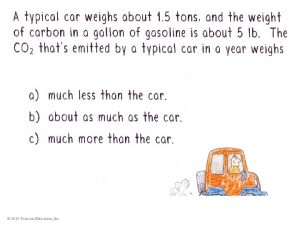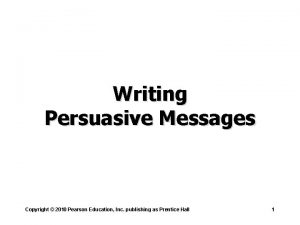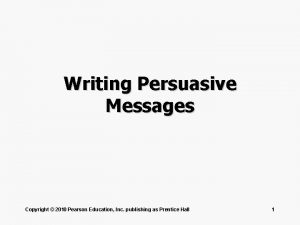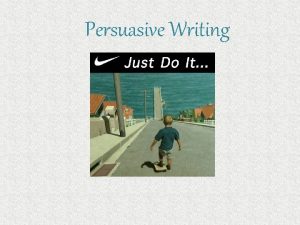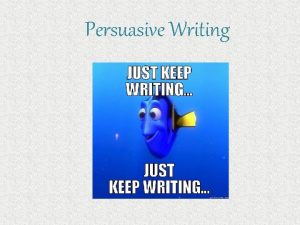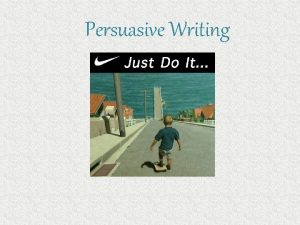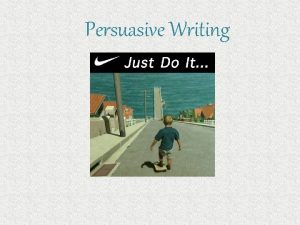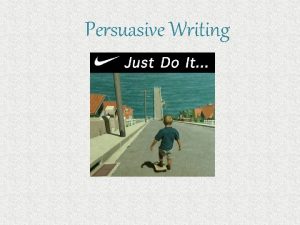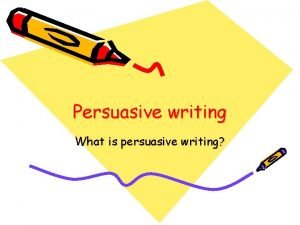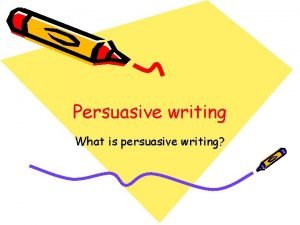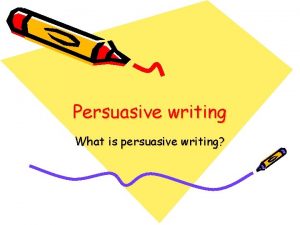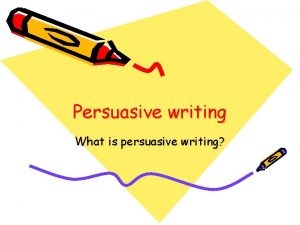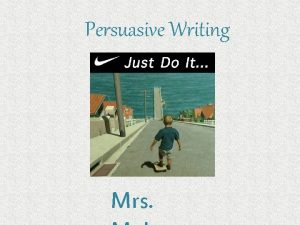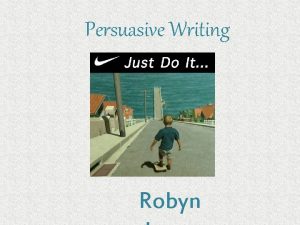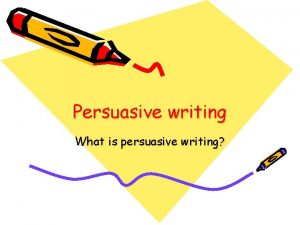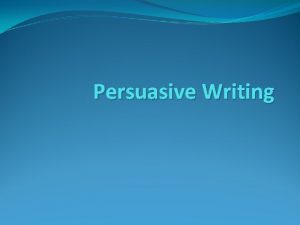Writing Persuasive Messages Copyright 2010 Pearson Education Inc






























- Slides: 30

Writing Persuasive Messages Copyright © 2010 Pearson Education, Inc. publishing as Prentice Hall 1

Learning Objectives • Apply the three-step writing process to persuasive messages • Identify seven ways to establish credibility in persuasive messages • Describe the AIDA model for persuasive messages Copyright © 2010 Pearson Education, Inc. publishing as Prentice Hall 2

Learning Objectives • Distinguish between emotional and logical appeals and discuss how to balance them • Describe five essential steps in developing sales and marketing messages • Identify steps you can take to avoid ethical lapses in marketing and sales messages Copyright © 2010 Pearson Education, Inc. publishing as Prentice Hall 3

The Three-Step Process • Persuasion – Asking for something of value – Asking audience to take action Copyright © 2010 Pearson Education, Inc. publishing as Prentice Hall 4

Plan the Message • Analyze your situation • Gather information • Select the medium • Organize your information Copyright © 2010 Pearson Education, Inc. publishing as Prentice Hall 5

Analyze the Situation • Audience • Purpose – Demographics – Request action – Psychographics – Prompt decisions – Motivation – Change attitudes Copyright © 2010 Pearson Education, Inc. publishing as Prentice Hall 6

Gather Information • Knowledge • Beliefs • Emotions Copyright © 2010 Pearson Education, Inc. publishing as Prentice Hall 7

Select the Medium • Electronic mail • Social media • Personal attention • Technological reach Copyright © 2010 Pearson Education, Inc. publishing as Prentice Hall 8

Organize the Message • Direct or indirect approach – Audience focus – Limited scope – Audience reaction – Power and expertise Copyright © 2010 Pearson Education, Inc. publishing as Prentice Hall 9

Write the Message • Use positive, polite language • Respect cultural differences • Understand corporate cultures • Establish your credibility Copyright © 2010 Pearson Education, Inc. publishing as Prentice Hall 10

Enhance Your Credibility Assess Your Credibility Find Common Ground Use Simple Language Be Objective and Fair Provide Evidence Consider the Audience Identify Sources Avoid the “Hard Sell” Copyright © 2010 Pearson Education, Inc. publishing as Prentice Hall 11

Completing the Message • Evaluate the content • Critique design elements • Proofread the message • Select the delivery method Copyright © 2010 Pearson Education, Inc. publishing as Prentice Hall 12

Persuasive Messages • Four essential strategies – Frame your arguments (AIDA Model) – Balance emotion and logic – Reinforce your position – Anticipate objections Copyright © 2010 Pearson Education, Inc. publishing as Prentice Hall 13

Using the AIDA Model • Attention • Interest • Desire • Action Copyright © 2010 Pearson Education, Inc. publishing as Prentice Hall 14

Write Balanced Messages • Emotions • Logic – Feelings – Analogy – Sympathies – Induction – Needs – Deduction Copyright © 2010 Pearson Education, Inc. publishing as Prentice Hall 15

Avoiding Faulty Logic • • Hasty generalizations Circular reasoning Attacking the opponent Oversimplification Cause and effect assumptions Faulty analogies Illogical support Copyright © 2010 Pearson Education, Inc. publishing as Prentice Hall 16

Reinforce Your Position • Powerful words • Figures of speech • Right timing Copyright © 2010 Pearson Education, Inc. publishing as Prentice Hall 17

Anticipate Objections • Test your theories • Ask the audience • Present all sides Copyright © 2010 Pearson Education, Inc. publishing as Prentice Hall 18

Types of Persuasive Messages • Requests for action • Presentation of ideas • Requests for claims or adjustments Copyright © 2010 Pearson Education, Inc. publishing as Prentice Hall 19

Marketing and Selling • Marketing messages – Information – Goodwill • Sales messages – Action – Purchase Copyright © 2010 Pearson Education, Inc. publishing as Prentice Hall 20

Applying the Strategies • Assess audience needs • Analyze the competition • Present key selling points • Highlight the benefits Copyright © 2010 Pearson Education, Inc. publishing as Prentice Hall 21

Anticipating Objections • High price • Poor quality • Compatibility • Perceived risk Copyright © 2010 Pearson Education, Inc. publishing as Prentice Hall 22

Applying the AIDA Model • Getting attention • Building interest • Increasing desire • Motivating action Copyright © 2010 Pearson Education, Inc. publishing as Prentice Hall 23

Getting Attention Product Benefits Common Ground Personal Appeals Inside Information Promised Savings Product Samples Problem Solutions Evocative Images Copyright © 2010 Pearson Education, Inc. publishing as Prentice Hall Genuine News 24

Building Interest • Build intrigue • Support promises • Highlight benefits Copyright © 2010 Pearson Education, Inc. publishing as Prentice Hall 25

Increasing Desire • Focus on the audience • Emphasize the benefits • Support your claims Copyright © 2010 Pearson Education, Inc. publishing as Prentice Hall 26

Motivating Action • The next step • A sense of urgency • Professionalism Copyright © 2010 Pearson Education, Inc. publishing as Prentice Hall 27

Using Social Media • Conversation marketing and social commerce – Interactive – Networked – Multidirectional – Persuasive Copyright © 2010 Pearson Education, Inc. publishing as Prentice Hall 28

Social Media Guidelines • Facilitate community building • Initiate and respond to conversations • Identify and support your champions • Don’t rely on the news media • Use the AIDA model as needed Copyright © 2010 Pearson Education, Inc. publishing as Prentice Hall 29

Maintaining High Standards • Business ethics • Legal compliance • Business etiquette Copyright © 2010 Pearson Education, Inc. publishing as Prentice Hall 30
 2010 pearson education inc
2010 pearson education inc Copyright 2010 pearson education inc
Copyright 2010 pearson education inc Copyright 2010 pearson education inc
Copyright 2010 pearson education inc Copyright 2010 pearson education inc
Copyright 2010 pearson education inc Copyright 2010 pearson education inc
Copyright 2010 pearson education inc Copyright 2010 pearson education inc
Copyright 2010 pearson education inc 2010 pearson education inc
2010 pearson education inc Copyright 2010 pearson education inc
Copyright 2010 pearson education inc Composition copyright example
Composition copyright example Copyright 2010 pearson education inc
Copyright 2010 pearson education inc 2017 pearson education inc
2017 pearson education inc 2017 pearson education inc
2017 pearson education inc Copyright 2009
Copyright 2009 2018 pearson education inc
2018 pearson education inc 2014 pearson education inc
2014 pearson education inc Copyright by pearson education inc. answers
Copyright by pearson education inc. answers 2008 pearson education inc
2008 pearson education inc Copyright 2009 pearson education inc
Copyright 2009 pearson education inc Copyright pearson education inc
Copyright pearson education inc Copyright 2009 pearson education inc
Copyright 2009 pearson education inc 2009 pearson education inc
2009 pearson education inc Copyright 2009 pearson education inc
Copyright 2009 pearson education inc Copyright 2009 pearson education inc
Copyright 2009 pearson education inc Copyright pearson education inc
Copyright pearson education inc 2010 pearson education inc
2010 pearson education inc 2010 pearson education inc answers
2010 pearson education inc answers 2010 pearson education inc answers
2010 pearson education inc answers 2010 pearson education inc answers
2010 pearson education inc answers 2010 pearson education inc answers
2010 pearson education inc answers 2010 pearson education inc
2010 pearson education inc 2010 pearson education inc
2010 pearson education inc


























